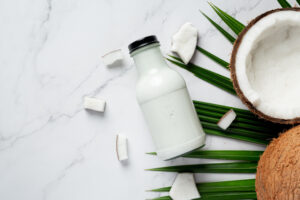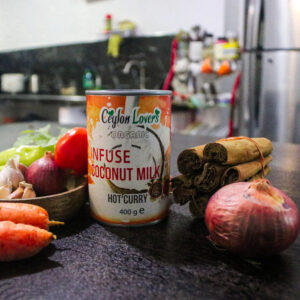Introduction
Coconut cream holds a unique allure in the realm of confections, captivating both seasoned dessert enthusiasts and culinary adventurers alike. This introduction serves as a gateway to unraveling the charm and versatility of coconut cream in dessert-making, offering insights into its historical significance and contemporary appeal.
Overview of the Allure of Coconut Cream in Confections
Coconut cream’s luxurious texture and delicate flavor make it a coveted ingredient in the world of desserts. Its velvety consistency lends a creamy richness to sweets, while its subtle tropical notes add depth and complexity to confections. Whether it’s used to create decadent pies, silky puddings, or luscious cakes, coconut cream infuses desserts with an irresistible allure that delights the palate and tantalizes the senses.
Brief History of Coconut Cream in Dessert-Making
The journey of coconut cream in dessert-making traces back through centuries of culinary traditions and cultural practices. From its origins in tropical regions where coconuts flourish abundantly, coconut cream has been cherished for its versatility and flavor-enhancing properties. Throughout history, coconut cream has been a staple ingredient in traditional desserts across Asia, the Pacific Islands, and beyond, weaving its way into the fabric of diverse culinary heritages.
Purpose and Scope of the Book
In this book, we embark on a culinary exploration of coconut cream’s role in dessert-making, celebrating its rich history and exploring its contemporary applications. Through a curated collection of recipes, tips, and insights, we aim to inspire readers to unleash their creativity in the kitchen and experiment with coconut cream in a variety of confections. From classic favorites to innovative creations, this book offers a comprehensive guide to harnessing the magic of coconut cream to elevate your dessert repertoire.
As we delve into the allure of coconut cream in confections and trace its journey through time, we invite readers to join us on a flavorful adventure where every bite is infused with the tropical essence of coconut cream.
Understanding Coconut Cream
What is Coconut Cream? Coconut cream is a rich, creamy substance derived from the flesh of mature coconuts. It is extracted by grating the flesh and then pressing it to extract the creamy liquid. Coconut cream has a thick consistency and a luxurious texture, making it a popular ingredient in various culinary applications, particularly in desserts and savory dishes.
Nutritional Benefits and Versatility in Cooking Coconut cream is prized for its nutritional benefits and versatility in cooking. It is rich in healthy fats, particularly medium-chain triglycerides (MCTs), which are known for their potential health benefits, including improved metabolism and energy levels. Additionally, coconut cream contains vitamins and minerals such as potassium, iron, and vitamin C, adding to its nutritional value.
In cooking, coconut cream adds a luscious creaminess and a subtle coconut flavor to dishes. It can be used as a dairy alternative in both sweet and savory recipes, such as curries, soups, sauces, desserts, and beverages. Coconut cream is also a staple ingredient in many cuisines around the world, including Thai, Indian, Caribbean, and Pacific Island cuisines, where it is used to impart richness and flavor to traditional dishes.
Differentiating Coconut Cream from Coconut Milk and Other Coconut Products It’s important to distinguish coconut cream from other coconut products, such as coconut milk and coconut water. While coconut cream and coconut milk are both derived from the flesh of mature coconuts, they differ in their consistency and fat content.
Coconut cream has a higher fat content and thicker consistency compared to coconut milk. It is made by simmering coconut flesh in water and then straining it to separate the cream from the liquid. Coconut milk, on the other hand, is made using a similar process but with a higher ratio of water to coconut flesh, resulting in a thinner liquid with a lower fat content.
In addition to coconut cream and coconut milk, there are other coconut products available, such as coconut oil, coconut water, and desiccated coconut. These products vary in their composition and uses, with coconut oil being extracted from the dried kernel of the coconut and used primarily for cooking and skincare, while coconut water is the clear liquid found inside young coconuts and is valued for its hydration properties.
Understanding the differences between coconut cream, coconut milk, and other coconut products is essential for selecting the right ingredient for your culinary needs and ensuring the desired flavor and texture in your dishes.
Essential Ingredients and Equipment
When it comes to creating delectable confections with coconut cream, having the right ingredients and equipment is crucial to achieving the perfect balance of flavors and textures.
Quality Coconut Cream Selection: Selecting high-quality coconut cream is paramount to the success of your dessert creations. Look for coconut cream that is thick, creamy, and free from any additives or preservatives. Opt for brands that use minimal processing methods to retain the natural flavor and aroma of coconut. Consider factors such as consistency and fat content, as these can vary among different brands and can affect the final outcome of your desserts.
Cocoa and Chocolate Varieties: Cocoa and chocolate are staple ingredients in many coconut cream-based desserts, adding depth and richness to your creations. Experiment with different varieties of cocoa powder and chocolate, such as dark, milk, or white chocolate, to achieve the desired flavor profile. Choose high-quality cocoa and chocolate products with a rich and intense flavor, as these will elevate the taste of your desserts.
Sweeteners and Flavorings: Sweeteners and flavorings play a crucial role in enhancing the taste of coconut cream desserts. Explore a variety of sweeteners, such as cane sugar, maple syrup, or coconut sugar, to find the perfect balance of sweetness for your recipes. Additionally, experiment with different flavorings, such as vanilla extract, almond extract, or citrus zest, to add complexity and depth to your desserts. Consider the flavor profile of your dessert and adjust the amount of sweeteners and flavorings accordingly to achieve the desired taste.
Tools and Utensils Needed for Confectionery: Having the right tools and utensils on hand is essential for effortless confectionery. Invest in high-quality kitchen equipment such as mixing bowls, spatulas, whisks, and measuring cups and spoons to ensure accurate measurements and smooth preparation. Additionally, consider specialty tools such as pastry bags, piping tips, and silicone molds for shaping and decorating your coconut cream desserts with precision and finesse. Having a well-equipped kitchen will streamline the dessert-making process and allow you to create professional-quality confections with ease.
By carefully selecting quality ingredients and equipping yourself with the right tools and utensils, you’ll be well-prepared to embark on your culinary journey with coconut cream and create irresistible desserts that will delight the senses and impress your guests.
Basic Techniques
In the realm of dessert creation, mastering fundamental techniques is essential for achieving delicious and visually stunning results. Here, we delve into three basic techniques that play a crucial role in crafting irresistible coconut cream desserts:
Melting and Tempering Chocolate
- Melting chocolate is a foundational skill in dessert making, especially when crafting chocolate-based confections. To melt chocolate effectively, it’s important to use gentle heat and avoid overheating, which can cause the chocolate to seize.
- Tempering chocolate is the process of stabilizing melted chocolate to ensure it sets properly with a glossy finish and satisfying snap. This involves heating and cooling the chocolate to specific temperatures while agitating it to encourage the formation of stable cocoa butter crystals.
- Tips for successful melting and tempering include using high-quality chocolate, chopping it into small, uniform pieces for even melting, and using a double boiler or microwave in short intervals to control the temperature.
Emulsifying Coconut Cream
- Emulsification is the process of combining two or more immiscible ingredients, such as fat and water, to create a smooth and cohesive mixture. Coconut cream, with its rich and creamy texture, serves as an excellent base for emulsified desserts.
- When emulsifying coconut cream, it’s important to ensure that the ingredients are at similar temperatures to prevent curdling or separation. This can be achieved by gently heating the coconut cream and incorporating other ingredients slowly while whisking or blending continuously.
- Emulsified coconut cream desserts can range from silky-smooth mousses and custards to creamy sauces and frostings, offering a luscious texture and indulgent flavor profile.
Shaping and Decorating Confections
- Shaping and decorating are the finishing touches that elevate desserts from simple treats to works of art. Whether molding chocolates, piping frosting, or garnishing cakes, mastering shaping and decorating techniques allows for endless creativity and personalization.
- Techniques for shaping confections include using molds, hand-shaping truffles or bonbons, and cutting or molding dough for cookies or pastries. Precision and attention to detail are key to achieving uniform shapes and sizes.
- Decorating confections involves a variety of methods, such as piping, spreading, drizzling, and garnishing with fruits, nuts, or edible flowers. Techniques like chocolate tempering and sugar work allow for intricate designs and decorations that enhance the visual appeal of desserts.
Mastering these basic techniques lays the foundation for creating a wide range of coconut cream desserts, from elegantly sculpted truffles to intricately decorated cakes. With practice and creativity, dessert enthusiasts can unleash their culinary imagination and delight friends and family with delectable coconut cream creations.




